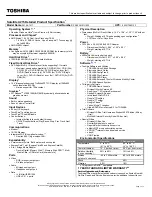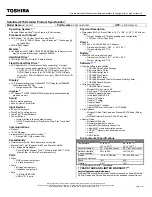
3-24
Troubleshooting and Diagnostics
HP Omnibook XT6050, XT/VT6200
Beep
Codes*
Error
Code
POST Description
2-1-3-1
48h
Check video configuration against CMOS.
2-1-3-2
49h
Initialize PCI bus and devices.
2-1-3-3
4Ah
Initialize all video adapters in system.
2-1-3-4
4Bh
QuietBoot start (optional).
2-1-4-1
4Ch
Shadow video BIOS ROM.
2-1-4-3
4Eh
Display BIOS copyright notice.
2-1-4-4
4Fh
Initialize MultiBoot.
2-2-1-1
50h
Display CPU type and speed.
2-2-1-2
51h
Initialize EISA board.
2-2-1-3
52h
Test keyboard.
2-2-2-1
54h
Set key click if enabled.
2-2-2-2
55h
Enable USB devices.
2-2-3-1
58h
Test for unexpected interrupts.
2-2-3-2
59h
Initialize POST display service.
2-2-3-3
5Ah
Display prompt "Press F2 to enter SETUP".
2-2-3-4
5Bh
Disable CPU cache.
2-2-4-1
5Ch
Test RAM between 512 and 640 kB.
2-3-1-1
60h
Test extended memory.
2-3-1-3
62h
Test extended memory address lines.
2-3-2-1
64h
Jump to UserPatch1.
2-3-2-3
66h
Configure advanced cache registers.
2-3-2-4
67h
Initialize Multi Processor APIC.
2-3-3-1
68h
Enable external and CPU caches.
2-3-3-2
69h
Set up System Management Mode (SMM)
area.
2-3-3-3
6Ah
Display external L2 cache size.
2-3-3-4
6Bh
Load custom defaults (optional).
2-3-4-1
6Ch
Display shadow-area message.
2-3-4-3
6Eh
Display possible high address for UMB
recovery.
2-4-1-1
70h
Display error messages.
2-4-1-3
72h
Check for configuration errors.
2-4-2-3
76h
Check for keyboard errors.
2-4-4-1
7Ch
Set up hardware interrupt vectors.
2-4-4-2
7Dh
Initialize Intelligent System Monitoring.
2-4-4-3
7Eh
Initialize coprocessor if present.
3-1-1-1
80h
Disable onboard Super I/O ports and IRQs.
3-1-1-2
81h
Late POST device initialization.
3-1-1-3
82h
Detect and install external RS232 ports.
3-1-1-4
83h
Configure non-MCD IDE controllers.
3-1-2-1
84h
Detect and install external parallel ports.
3-1-2-2
85h
Initialize PC-compatible PnP ISA devices.
3-1-2-3
86h
Re-initialize onboard I/O ports.
3-1-2-4
87h
Configure Motherboard Configurable Devices
(optional).
3-1-3-1
88h
Initialize BIOS Data Area.
3-1-3-2
89h
Enable Non-Maskable Interrupts (NMIs).
3-1-3-3
8Ah
Initialize Extended BIOS Data Area.
3-1-3-4
8Bh
Test and initialize PS/2 mouse.
3-1-4-1
8Ch
Initialize floppy controller.
3-1-4-4
8Fh
Determine number of ATA drives (optional).
3-2-1-1
90h
Initialize hard-disk controllers.
3-2-1-2
91h
Initialize local-bus hard-disk controllers.
3-2-1-3
92h
Jump to UserPatch2.
3-2-1-4
93h
Build MPTABLE for multi-processor boards.
3-2-2-2
95h
Install CD-ROM for boot.
3-2-2-3
96h
Clear huge ES segment register.
3-2-2-4
97h
Fix up Multi Processor table.
3-2-3-2
99h
Check for SMART Drive (optional).
3-2-3-3
9Ah
Shadow option ROMs.
3-2-4-1
9Ch
Set up Power Management.
3-2-4-2
9Dh
Initialize security engine (optional).
3-2-4-3
9Eh
Enable hardware interrupts.
3-2-4-4
9Fh
Determine number of ATA and SCSI drives.
3-3-1-1
A0h
Set time of day.
3-3-1-3
A2h
Check key lock.
Beep
Codes*
Error
Code
POST Description
3-3-2-1
A4h
Initialize typematic rate.
3-3-3-1
A8h
Erase F2 prompt.
3-3-3-3
AAh
Scan for F2 keystroke.
3-3-4-1
ACh
Enter SETUP.
3-3-4-3
AEh
Clear Boot flag.
3-4-1-1
B0h
Check for errors.
3-4-1-2
B1h
Inform RomPilot about the end of POST.
3-4-1-3
B2h
POST done - prepare to boot OS.
3-4-2-2
B5h
Terminate QuietBoot (optional).
3-4-2-3
B6h
Check password (optional).
3-4-2-4
B7h
Initialize ACPI BIOS.
3-4-3-2
B9h
Prepare Boot.
3-4-3-3
BAh
Initialize SMBIOS.
3-4-3-4
BBh
Initialize PnP Option ROMs.
3-4-4-1
BCh
Clear parity checkers.
3-4-4-2
BDh
Display MultiBoot menu.
3-4-4-3
BEh
Clear screen (optional).
3-4-4-4
BFh
Check virus and backup reminders.
4-1-1-1
C0h
Try to boot with INT 19.
4-1-1-2
C1h
Initialize POST Error Manager (PEM).
4-1-1-3
C2h
Initialize error logging.
4-1-1-4
C3h
Initialize error display function.
4-1-2-1
C4h
Initialize system error handler.
4-1-2-2
C5h
PnPnd dual CMOS (optional).
4-1-2-3
C6h
Initialize note dock (optional).
4-1-2-4
C7h
Initialize note dock late.
4-1-3-1
C8h
Force check (optional).
4-1-3-2
C9h
Extended checksum (optional).
4-1-3-3
CAh
Redirect Int 15h to enable remote keyboard.
4-1-3-4
CBh
Redirect Int 13h to Memory Technologies
Devices such as ROM, RAM, PCMCIA, and
serial disk.
4-1-4-1
CCh
Redirect Int 10h to enable remote serial
video.
4-1-4-2
CDh
Re-map I/O and memory for PCMCIA.
4-1-4-3
CEh
Initialize digitizer and display message.
4-2-1-3
D2h
Unknown interrupt.
4-3-1-1
E0h
Initialize the chipset.
4-3-1-2
E1h
Initialize the bridge.
4-3-1-3
E2h
Initialize the CPU.
4-3-1-4
E3h
Initialize system timer.
4-3-2-1
E4h
Initialize system I/O.
4-3-2-2
E5h
Check force recovery boot.
4-3-2-3
E6h
Checksum BIOS ROM.
4-3-2-4
E7h
Go to BIOS.
4-3-3-1
E8h
Set Huge Segment.
4-3-3-2
E9h
Initialize Multi Processor.
4-3-3-3
EAh
Initialize OEM special code.
4-3-3-4
EBh
Initialize PIC and DMA.
4-3-4-1
ECh
Initialize Memory type.
4-3-4-2
EDh
Initialize Memory size.
4-3-4-3
EEh
Shadow Boot Block.
4-3-4-4
EFh
System memory test.
4-4-1-1
F0h
Initialize interrupt vectors.
4-4-1-2
F1h
Initialize Run Time Clock.
4-4-1-3
F2h
Initialize video.
4-4-1-4
F3h
Initialize System Management Manager.
4-4-2-1
F4h
Output one beep.
4-4-2-2
F5h
Clear Huge Segment.
4-4-2-3
F6h
Boot to Mini DOS.
4-4-2-4
F7h
Boot to Full DOS.
1 long,
2 short
98h
Improper video configuration (replace
motherboard) or external ROM checksum
failure.
Summary of Contents for OmniBook VT6200
Page 1: ... HP Omnibook XT6050 HP Omnibook XT VT6200 Technology Codes EF EG Service Manual ...
Page 22: ......
Page 56: ......
Page 90: ...4 2 Replaceable Parts HP Omnibook XT6050 XT VT6200 Figure 4 1 Exploded View ...
Page 100: ......
Page 105: ......
Page 106: ...Part Number F4506 90026 Printed in U S A 4 02 ...
















































